Page 349 of 432
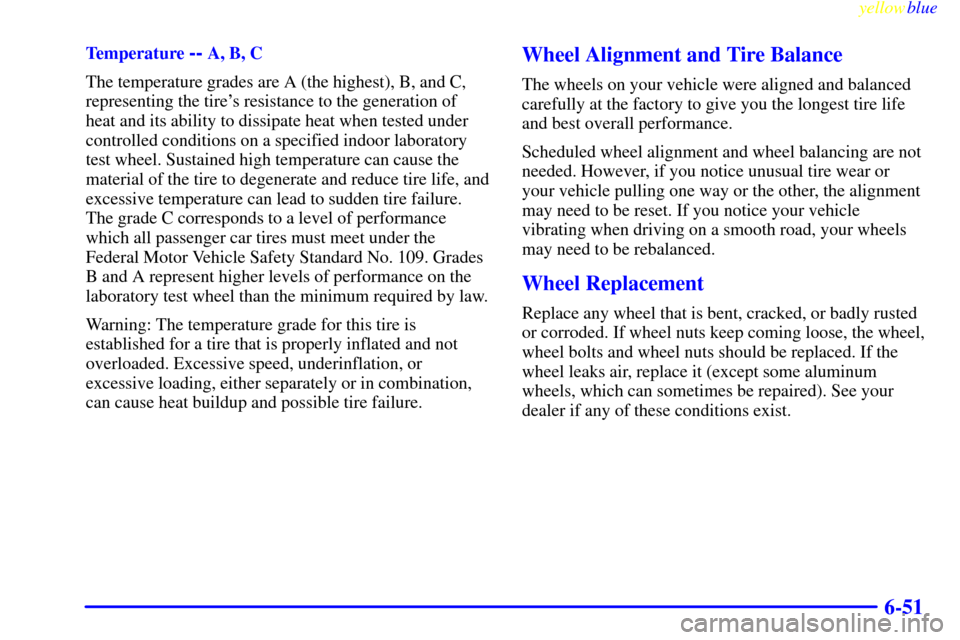
yellowblue
6-51
Temperature -- A, B, C
The temperature grades are A (the highest), B, and C,
representing the tire's resistance to the generation of
heat and its ability to dissipate heat when tested under
controlled conditions on a specified indoor laboratory
test wheel. Sustained high temperature can cause the
material of the tire to degenerate and reduce tire life, and
excessive temperature can lead to sudden tire failure.
The grade C corresponds to a level of performance
which all passenger car tires must meet under the
Federal Motor Vehicle Safety Standard No. 109. Grades
B and A represent higher levels of performance on the
laboratory test wheel than the minimum required by law.
Warning: The temperature grade for this tire is
established for a tire that is properly inflated and not
overloaded. Excessive speed, underinflation, or
excessive loading, either separately or in combination,
can cause heat buildup and possible tire failure.Wheel Alignment and Tire Balance
The wheels on your vehicle were aligned and balanced
carefully at the factory to give you the longest tire life
and best overall performance.
Scheduled wheel alignment and wheel balancing are not
needed. However, if you notice unusual tire wear or
your vehicle pulling one way or the other, the alignment
may need to be reset. If you notice your vehicle
vibrating when driving on a smooth road, your wheels
may need to be rebalanced.
Wheel Replacement
Replace any wheel that is bent, cracked, or badly rusted
or corroded. If wheel nuts keep coming loose, the wheel,
wheel bolts and wheel nuts should be replaced. If the
wheel leaks air, replace it (except some aluminum
wheels, which can sometimes be repaired). See your
dealer if any of these conditions exist.
Page 350 of 432

yellowblue
6-52
Your dealer will know the kind of wheel you need.
Each new wheel should have the same load
-carrying
capacity, diameter, width, offset and be mounted the
same way as the one it replaces.
If you need to replace any of your wheels, wheel bolts
or wheel nuts, replace them only with new GM original
equipment parts. This way, you will be sure to have the
right wheel, wheel bolts and wheel nuts for your vehicle.
CAUTION:
Using the wrong replacement wheels, wheel bolts
or wheel nuts on your vehicle can be dangerous.
It could affect the braking and handling of your
vehicle, make your tires lose air and make
you lose control. You could have a collision in
which you or others could be injured. Always
use the correct wheel, wheel bolts and wheel nuts
for replacement.
NOTICE:
The wrong wheel can also cause problems with
bearing life, brake cooling, speedometer or
odometer calibration, headlamp aim, bumper
height, vehicle ground clearance and tire or tire
chain clearance to the body and chassis.
See ªChanging a Flat Tireº in the Index for
more information.
Used Replacement Wheels
CAUTION:
Putting a used wheel on your vehicle is
dangerous. You can't know how it's been used or
how far it's been driven. It could fail suddenly
and cause an accident. If you have to replace a
wheel, use a new GM original equipment wheel.
Page 351 of 432
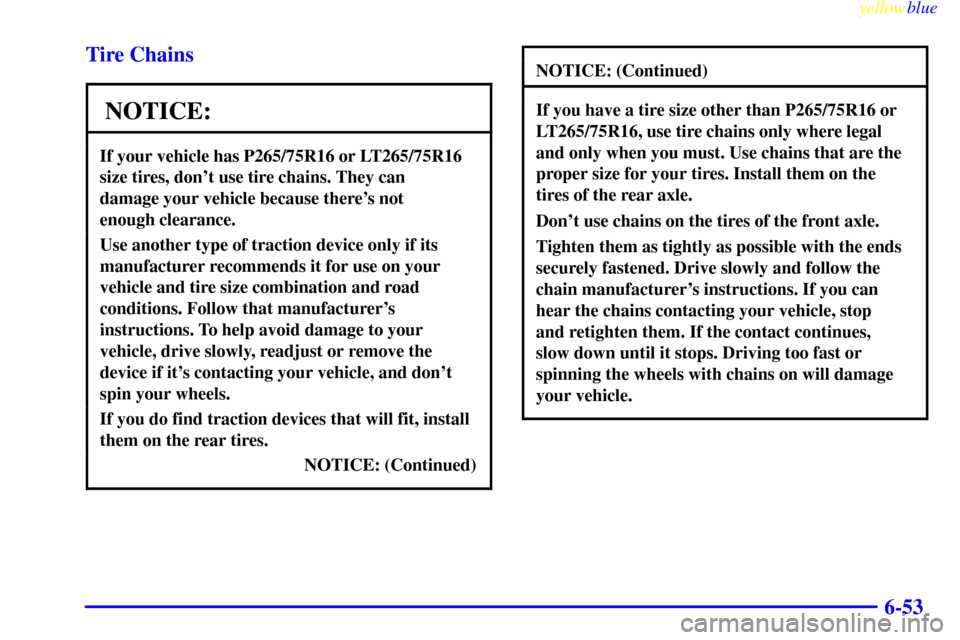
yellowblue
6-53 Tire Chains
NOTICE:
If your vehicle has P265/75R16 or LT265/75R16
size tires, don't use tire chains. They can
damage your vehicle because there's not
enough clearance.
Use another type of traction device only if its
manufacturer recommends it for use on your
vehicle and tire size combination and road
conditions. Follow that manufacturer's
instructions. To help avoid damage to your
vehicle, drive slowly, readjust or remove the
device if it's contacting your vehicle, and don't
spin your wheels.
If you do find traction devices that will fit, install
them on the rear tires.
NOTICE: (Continued)
NOTICE: (Continued)
If you have a tire size other than P265/75R16 or
LT265/75R16, use tire chains only where legal
and only when you must. Use chains that are the
proper size for your tires. Install them on the
tires of the rear axle.
Don't use chains on the tires of the front axle.
Tighten them as tightly as possible with the ends
securely fastened. Drive slowly and follow the
chain manufacturer's instructions. If you can
hear the chains contacting your vehicle, stop
and retighten them. If the contact continues,
slow down until it stops. Driving too fast or
spinning the wheels with chains on will damage
your vehicle.
Page 358 of 432
yellowblue
6-60
Cleaning Tires
To clean your tires, use a stiff brush with a tire cleaner.
NOTICE:
When applying a tire dressing always take care to
wipe off any overspray or splash from all painted
surfaces on the body or wheels of the vehicle.
Petroleum
-based products may damage the paint
finish and tires.
Sheet Metal Damage
If your vehicle is damaged and requires sheet metal
repair or replacement, make sure the body repair shop
applies anti
-corrosion material to the parts repaired or
replaced to restore corrosion protection.
Finish Damage
Any stone chips, fractures or deep scratches in the finish
should be repaired right away. Bare metal will corrode
quickly and may develop into a major repair expense.
Minor chips and scratches can be repaired with touch
-up
materials available from your dealer or other service
outlets. Larger areas of finish damage can be corrected
in your dealer's body and paint shop.
Page 372 of 432
yellowblue
6-74
Capacities and Specifications
Please refer to ªRecommended Fluids and Lubricantsº in the Index for more information.
Engine Type VIN Code Spark Plug Gap
VORTEC 4300 V6 W 0.060 inches (1.52 mm)
VORTEC 4800 V8 V 0.060 inches (1.52 mm)
VORTEC 5300 V8 T 0.060 inches (1.52 mm)
VORTEC 6000 V8 U 0.060 inches (1.52 mm)
Wheels and Tires
Model Description Torque
C/K 1500 6 bolts (14mm)
140 lb
-ft (190 N´m)
C/K 2500 8 bolts (14mm)
140 lb
-ft (190 N´m)
Tire Pressure See the Certification/Tire label on the rear edge of the driver's door
or the incomplete vehicle document in the cab.
Page 383 of 432
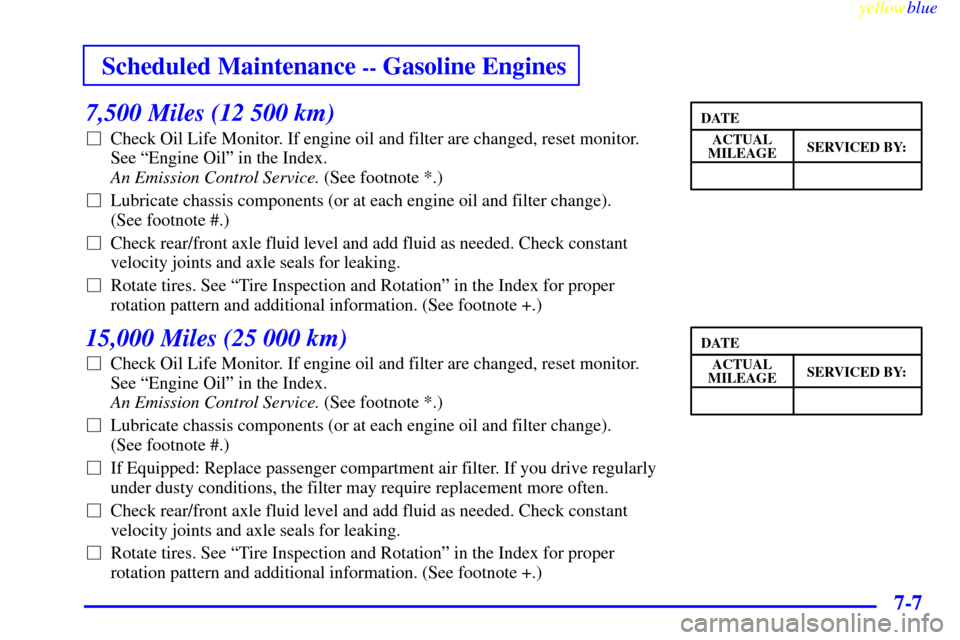
yellowblue
Scheduled Maintenance -- Gasoline Engines
7-7
7,500 Miles (12 500 km)
�Check Oil Life Monitor. If engine oil and filter are changed, reset monitor.
See ªEngine Oilº in the Index.
An Emission Control Service. (See footnote *.)
�Lubricate chassis components (or at each engine oil and filter change).
(See footnote #.)
�Check rear/front axle fluid level and add fluid as needed. Check constant
velocity joints and axle seals for leaking.
�Rotate tires. See ªTire Inspection and Rotationº in the Index for proper
rotation pattern and additional information. (See footnote +.)
15,000 Miles (25 000 km)
�Check Oil Life Monitor. If engine oil and filter are changed, reset monitor.
See ªEngine Oilº in the Index.
An Emission Control Service. (See footnote *.)
�Lubricate chassis components (or at each engine oil and filter change).
(See footnote #.)
�If Equipped: Replace passenger compartment air filter. If you drive regularly
under dusty conditions, the filter may require replacement more often.
�Check rear/front axle fluid level and add fluid as needed. Check constant
velocity joints and axle seals for leaking.
�Rotate tires. See ªTire Inspection and Rotationº in the Index for proper
rotation pattern and additional information. (See footnote +.)
ACTUAL
SERVICED BY:MILEAGE
DATE
ACTUAL
SERVICED BY:MILEAGE
DATE
Page 384 of 432
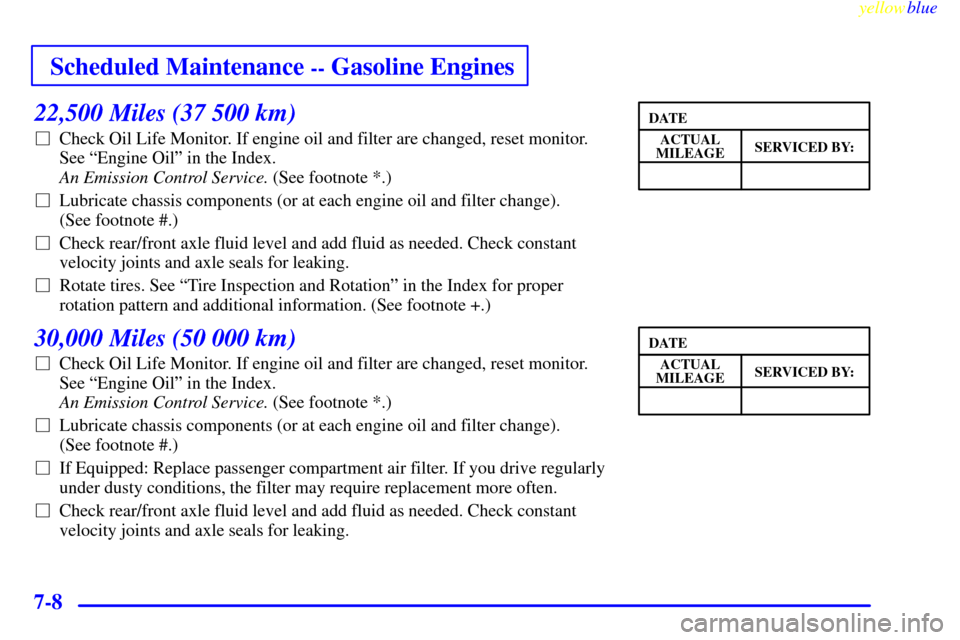
Scheduled Maintenance -- Gasoline Engines
yellowblue
7-8
22,500 Miles (37 500 km)
�Check Oil Life Monitor. If engine oil and filter are changed, reset monitor.
See ªEngine Oilº in the Index.
An Emission Control Service. (See footnote *.)
�Lubricate chassis components (or at each engine oil and filter change).
(See footnote #.)
�Check rear/front axle fluid level and add fluid as needed. Check constant
velocity joints and axle seals for leaking.
�Rotate tires. See ªTire Inspection and Rotationº in the Index for proper
rotation pattern and additional information. (See footnote +.)
30,000 Miles (50 000 km)
�Check Oil Life Monitor. If engine oil and filter are changed, reset monitor.
See ªEngine Oilº in the Index.
An Emission Control Service. (See footnote *.)
�Lubricate chassis components (or at each engine oil and filter change).
(See footnote #.)
�If Equipped: Replace passenger compartment air filter. If you drive regularly
under dusty conditions, the filter may require replacement more often.
�Check rear/front axle fluid level and add fluid as needed. Check constant
velocity joints and axle seals for leaking.
ACTUAL
SERVICED BY:MILEAGE
DATE
ACTUAL
SERVICED BY:MILEAGE
DATE
Page 385 of 432
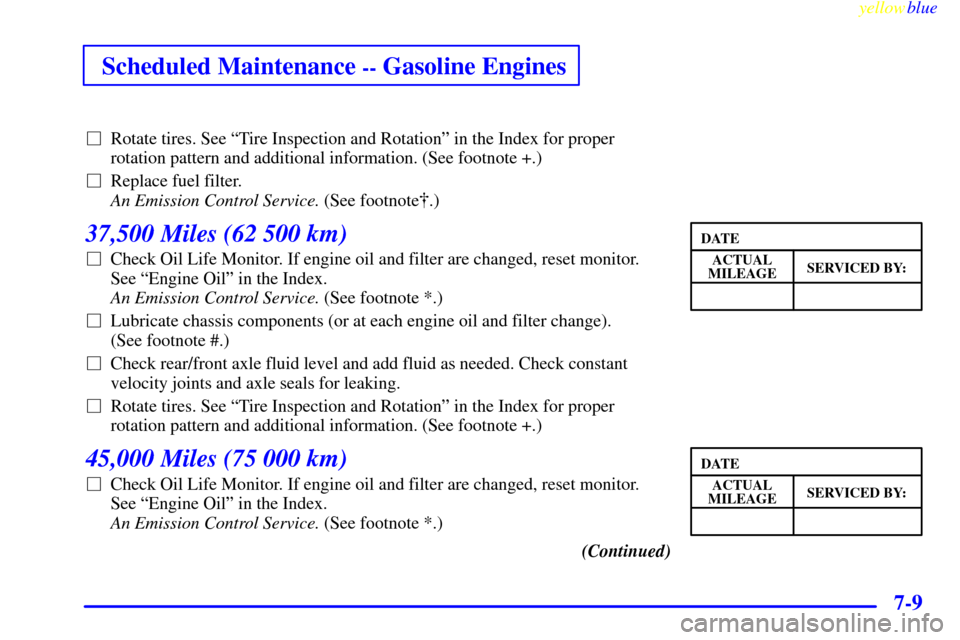
yellowblue
Scheduled Maintenance -- Gasoline Engines
7-9
�Rotate tires. See ªTire Inspection and Rotationº in the Index for proper
rotation pattern and additional information. (See footnote +.)
�Replace fuel filter.
An Emission Control Service. (See footnote�.)
37,500 Miles (62 500 km)
�Check Oil Life Monitor. If engine oil and filter are changed, reset monitor.
See ªEngine Oilº in the Index.
An Emission Control Service. (See footnote *.)
�Lubricate chassis components (or at each engine oil and filter change).
(See footnote #.)
�Check rear/front axle fluid level and add fluid as needed. Check constant
velocity joints and axle seals for leaking.
�Rotate tires. See ªTire Inspection and Rotationº in the Index for proper
rotation pattern and additional information. (See footnote +.)
45,000 Miles (75 000 km)
�Check Oil Life Monitor. If engine oil and filter are changed, reset monitor.
See ªEngine Oilº in the Index.
An Emission Control Service. (See footnote *.)
(Continued)
ACTUAL
SERVICED BY:MILEAGE
DATE
ACTUAL
SERVICED BY:MILEAGE
DATE